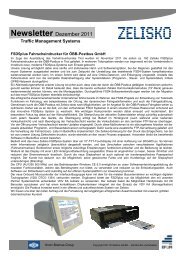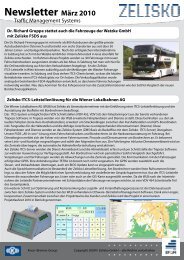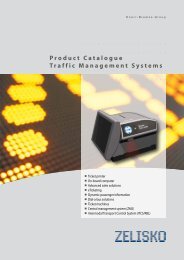Annual Report 2012 - Knorr-Bremse AG.
Annual Report 2012 - Knorr-Bremse AG.
Annual Report 2012 - Knorr-Bremse AG.
Create successful ePaper yourself
Turn your PDF publications into a flip-book with our unique Google optimized e-Paper software.
<strong>Report</strong><br />
119<br />
India Rail orders brake calipers and discs for passenger trains<br />
During the year under review India’s state railway operator India Rail ordered 550 new passenger train<br />
cars from manufacturer Rail Coach Factory (RCF), which build the vehicles in collaboration with<br />
Alstom at its Indian plant in Kapurthala. As part of this order, <strong>Knorr</strong>-<strong>Bremse</strong> is to equip the trains with<br />
brake discs and calipers, with deliveries starting in spring 2013. In the course of its expansion of the<br />
national rail infrastructure, India is planning to buy up to 2,000 new passenger cars per year in the<br />
medium term – and <strong>Knorr</strong>-<strong>Bremse</strong> stands to benefit from these orders as well.<br />
Smart Car application added to EP 60<br />
Etihad Rail, the newly created operator of the United Arab Emirates (UAE) national rail network, has<br />
ordered 240 bulk freight cars from Chinese manufacturer CSR Yangtze Rolling Stock for the transportation<br />
of pelletized sulfur. The cars are equipped with the field-proven EP 60 electro-pneumatic braking<br />
system from <strong>Knorr</strong>-<strong>Bremse</strong> subsidiary New York Air Brake (NYAB). EP 60 transmits the air brake<br />
signal from the locomotive to the cars over the train’s wired communication network. The brake signal<br />
reaches every car at virtually the same time, so that the brakes are applied on each car simultaneously.<br />
This prevents the typical train-handling challenge for pneumatic brakes on long, heavy trains<br />
where the brakes on the front cars are applied while the rear cars remain momentarily unbraked,<br />
resulting in potentially dangerous run-in force events.<br />
In conjunction with<br />
Australian mining<br />
giant Rio Tinto, NYAB<br />
is working on<br />
controlling driverless<br />
trains with LEADER.<br />
In a major technology step, NYAB added Smart Car functionality to its EP 60 braking system. The 240<br />
cars for Etihad Rail will be the first in the world where wireless Smart Car capability has been installed.<br />
This new application utilizes the train’s existing EP 60 train-line communication network to<br />
both control and verify the open/closed status of the loading hatches and unloading doors on the<br />
cars. Perhaps the most important feature in the new Smart Car is the wireless hot-bearing sensors<br />
included on each car. Along with the bulk freight cars, the operator’s seven new Progress Rail – EMD<br />
locomotives will also be equipped with the appropriate Smart Car software, interfaced to the EP 60<br />
system.<br />
<strong>Knorr</strong>-<strong>Bremse</strong> develops LEADER AutoPilot for Rio Tinto<br />
<strong>Knorr</strong>-<strong>Bremse</strong>’s LEADER system is a unique measuring and control technology for trains that results in<br />
reduced fuel consumption, more efficient schedule management and a reduction of in-train forces.<br />
It does so by evaluating the dynamic state of the train in real time and determining driving strategies<br />
to improve overall energy efficiency. LEADER enables fuel savings of between 8% and 12% to be<br />
achieved and also reduces in-train forces by up to 50%. The system also has a positive impact on<br />
schedule management, helping to improve network utilization.<br />
In the field of heavy freight trains <strong>Knorr</strong>-<strong>Bremse</strong> is currently supplying six major customers with LEAD-<br />
ER systems. One is for Anglo-Australian mining group Rio Tinto and represents the greatest challenge<br />
so far in this field. Rio Tinto’s goal is to operate driverless trains by 2015, with LEADER taking over control<br />
– which will involve extensive further technical development of the current LEADER system. However,<br />
the operational improvements it promises are so convincing that the effort is well worthwhile.<br />
The LEADER application being developed for Rio Tinto extends the system’s function from making<br />
recommendations to taking over complete control of the train. “Leader AutoPilot”, as it is known, requires<br />
active communication links with the network management system and the locomotive control<br />
system in order to directly trigger train commands. LEADER optimizes the train setup, including<br />
several locomotives and ECP braking systems.<br />
The system’s core software is already capable of taking over this sort of control task, but at present<br />
only passes on recommendations to the driver. In order to meet the safety standards necessary for



![1 Newsletter 2013 Version 0 92 [Kompatibilitätsmodus] - Zelisko](https://img.yumpu.com/50939577/1/184x260/1-newsletter-2013-version-0-92-kompatibilitaatsmodus-zelisko.jpg?quality=85)




![Backofficelösung ZMS [PDF, 740 kB] - Zelisko](https://img.yumpu.com/33964695/1/184x260/backofficelaasung-zms-pdf-740-kb-zelisko.jpg?quality=85)

![Geschäftsbericht 2012 [PDF, 13 MB] - Zelisko](https://img.yumpu.com/31517535/1/184x260/geschaaftsbericht-2012-pdf-13-mb-zelisko.jpg?quality=85)


![Produktkatalog Gesamtlösungen [PDF, 4 MB] - Zelisko](https://img.yumpu.com/22973479/1/182x260/produktkatalog-gesamtlaasungen-pdf-4-mb-zelisko.jpg?quality=85)
![ITCS Datenblatt [PDF, 804 kB] - Zelisko](https://img.yumpu.com/22855155/1/184x260/itcs-datenblatt-pdf-804-kb-zelisko.jpg?quality=85)
![Fahrscheindrucker FSD5plus [PDF, 934 kB] - Zelisko](https://img.yumpu.com/22822643/1/184x260/fahrscheindrucker-fsd5plus-pdf-934-kb-zelisko.jpg?quality=85)
